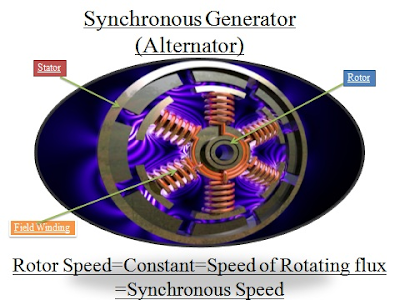Synchronous Generators and Motors: Short Notes
1. Definition and Construction of Synchronous Generators
Definition:
- A synchronous generator, also known as an alternator, is a device that converts mechanical energy into electrical energy in the form of alternating current (AC). It operates at a constant speed in synchrony with the frequency of the supply current.
Key Components and Construction:
- Stator: The stationary part of the generator containing the armature windings where the output AC is produced.
- Rotor: The rotating part of the generator that creates a rotating magnetic field. It is typically an electromagnet powered by direct current (DC).
- Exciter: Provides the DC current to the rotor windings.
- Prime Mover: An external mechanical force (e.g., steam turbine, water turbine, internal combustion engine) that drives the rotor.
- Bearings: Support the rotor and allow it to spin freely.
- Frame: The casing that holds all components together and protects the generator.
2. Working Principle of Synchronous Generators in Bullet Points
- Magnetic Field Generation: DC current supplied to the rotor winding creates a magnetic field.
- Rotor Rotation: The prime mover rotates the rotor.
- Electromagnetic Induction: As the rotor spins, the magnetic field rotates around the stator.
- AC Generation: The rotating magnetic field induces an alternating voltage in the stator windings according to Faraday's Law of Electromagnetic Induction.
- Synchronous Speed: The generator operates at a constant speed (synchronous speed) determined by the grid frequency and number of poles on the rotor.
3. Supplying DC Power to the Rotor of a Synchronous Generator
- Slip Rings and Brushes: DC power is often supplied to the rotor via slip rings and brushes, which maintain electrical contact with the rotating rotor.
- Brushless Exciters: Modern generators may use a brushless exciter, where an AC exciter (a smaller generator) produces AC, which is rectified to DC by rotating rectifiers directly on the rotor shaft.
- Static Exciters: In some systems, a static exciter uses stationary electronics to control and supply DC current to the rotor through slip rings.
4. Operating a Synchronous Generator Alone
- Prime Mover Speed: Ensure the prime mover can maintain the generator at its synchronous speed.
- Excitation System: Ensure the excitation system is functional and can supply the necessary DC current to the rotor.
- Voltage Build-Up: Gradually increase the excitation to build up the terminal voltage to the desired level.
- Load Connection: Connect the electrical load ensuring the generator can handle the load without dropping out of synchrony.
- Monitoring: Continuously monitor voltage, frequency, and load to maintain stable operation.
5. Parallel Operation of Synchronous Generators
- Synchronizing Conditions: Ensure both generators have the same voltage magnitude, frequency, and phase sequence.
- Synchronizing Equipment: Use synchronizing lamps or a synchroscope to match the phase angle of the incoming generator with the operating system.
- Synchronization Procedure:
- Bring the incoming generator up to the correct speed.
- Adjust the excitation to match the voltage.
- Use the synchroscope to close the breaker at the precise moment when the phase angles match.
- Load Sharing: After connection, adjust the governors and excitation systems to ensure proper load sharing between generators.
6. Key Differences between Synchronous Generators and Motors
Synchronous Generators:
- Function: Convert mechanical energy to electrical energy (AC).
- Prime Mover: Driven by external mechanical force.
- Application: Power generation in power plants.
- Operating Speed: Always operates at synchronous speed.
Synchronous Motors:
- Function: Convert electrical energy to mechanical energy.
- Prime Mover: Uses supplied AC power to generate mechanical torque.
- Application: Industrial applications requiring constant speed operation.
- Operating Speed: Runs at synchronous speed regardless of the load.
Key Distinct Characteristics:
- Generators output electrical power, while motors consume electrical power to produce mechanical work.
- Generators are generally used in power generation, whereas motors are used in various industrial and commercial mechanical drives.








No comments